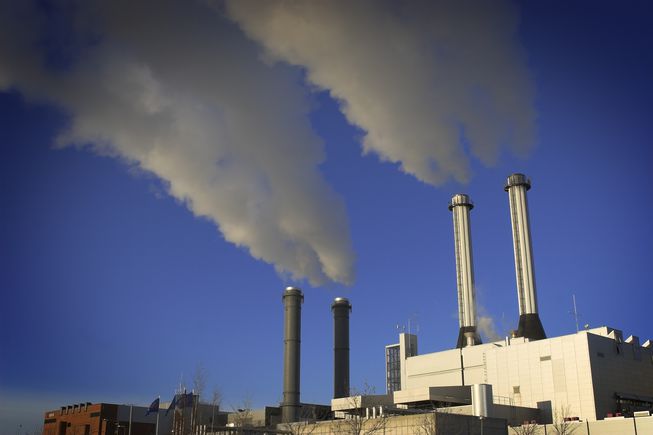More and more, America’s recyclable plastic is being burned, not recycled
Americans dutifully separate, sort and haul recyclables to the curb under the assumption that our bottles, cans and accumulated junk mail will avoid being landfilled and instead go somewhere to become something new.
And that somewhere has primarily been China, which has long accepted recyclables — plastics being the most prized — from the United States and other countries with enthusiastically open arms.
This all changed at the top of 2018 when the Chinese government implemented National Sword, a globally disruptive policy that’s seen the once-steady flow of recyclable waste into the country slow to a mere trickle — if even that — as China’s plastic imports have fallen by an astounding 99 percent. With officials citing pollution stemming from contaminated recyclables as the reason for the crackdown, Chinese manufacturers have since turned to the domestic waste stream for raw materials.
 America’s plastic waste crisis: Sorted, collected and nowhere to go. (Photo: Justin Sullivan/Getty Images)
America’s plastic waste crisis: Sorted, collected and nowhere to go. (Photo: Justin Sullivan/Getty Images)
Back in the U.S., most municipal recycling programs are — for now — still up and running, although many have drastically scaled back. In communities that haven’t found alternative markets in which to offload plastic, recyclable waste is staying putand being disposed of by other means, including being dumped in landfills or hauled to waste-to-energy incineration facilities.
That second option — incineration — may seem the preferable one.
Through incineration, plastic waste doesn’t run the risk of polluting waterways or sitting in a landfill for the next several thousand years. What’s more, numerous environmentally progressive European countries with high recycling rates have avoided overflowing landfills (and an over-dependence on fossil fuels like coal) by burning waste, using the energy produced during the incineration process as a renewable power and heat source.
While incineration may seem a viable way to deal with America’s quickly mounting plastic waste crisis in the short-term, it’s more complicated than that.
Although it generates more energy when incinerated, burning petroleum-based plastic can be more polluting than run-of-the-mill household solid waste. This is particularly true with regard to the release of highly toxic dioxins. Older incineration plants in the U.S. are also designed differently than clean-burning ones found in Scandinavia, which employ advanced emissions-control technologies to more effectively trap dangerous air pollutants (and sometimes feature snazzy artificial ski runs on their roofs.)
Simply put, while incinerating plastic may help tamp down one environmental nightmare, it can contribute to an entirely different one.
 A waste-to-energy incineration facility in Millbury, Massachusetts. (Photo: Massachusetts Department of Energy/Flickr)
A waste-to-energy incineration facility in Millbury, Massachusetts. (Photo: Massachusetts Department of Energy/Flickr)
In the shadow of Philly, a small city struggles with incineration
The incineration of plastic as a stopgap solution has picked up speed in numerous cities since China closed the door on waste imports. Much of the attention, however, has been placed on Philadelphia, which still offers curbside recycling, and has no plans to halt that service any time soon.
“There’s no interest in stopping recycling. That’s not in the plan at all,” the city’s environmental planner Scott McGrath told The Philadelphia Inquirer.
Roughly half of Philadelphia’s recyclable waste, however, is no longer being processed for recycling. Instead, it’s being burned just outside city limits, much to the surprise of many Philly residents. “It’s inflammatory on so many levels,” says Victoria Alsan of West Philadelphia. “It’s just very distressing.”
Writes The Inquirer:
The days when Philadelphia got paid for its recyclables have faded like the haze of burning trash. At least half of the items for recycling are now being incinerated because the price a contractor wanted to process them by separating paper, plastics, metals, and glass — as well as finding markets for them — became too high.
As The Guardian reports, roughly 200 tons of recyclable waste discarded by Philadelphians is now sent each day to a waste-to-energy incineration plant operated by Covanta Energy in nearby Chester, Pennsylvania, a plant that already burns 3,510 tons of non-recyclable trash every day.
 Half of Philadelphia’s recyclable waste is now sent to a nearby incineration facility. (Photo: Jeff Fusco/Getty Images)
Half of Philadelphia’s recyclable waste is now sent to a nearby incineration facility. (Photo: Jeff Fusco/Getty Images)
The other half of Philadelphia’s recyclable waste is hauled to regional recycling facilities for processing.
China’s new contamination standards require that imported recyclables be no more than .5 percent contaminated. The city’s contamination rates, however, range from 15 to 20 percent. As a city spokeswomen tells The Guardian, it is “virtually impossible to meet the stringent contamination standards established in China.”
This shift in how Philadelphia handles its recyclables has raised concerns about even further diminished air quality in neighboring Chester, an economically depressed city on the banks of the Delaware River with a history of environmental degradation that already struggles with serious public health woes including childhood asthma and lung cancer rates well above average compared to the rest of the state as reported by the Guardian.
The oldest city in Pennsylvania, Chester was a prosperous industrial and cultural hub during the first half of the 20th century. Today, over a third of the city’s predominantly African-American residents live below the poverty line whereas the rest of Delaware County, which includes inner-ring suburban Philadelphia’s Main Line communities, is largely white, affluent and unburdened by polluting industries. The situation in Chester is often used as a textbook example of environmental racism.
“Chester residents have borne the brunt of the whole region’s waste disposal problems for far too many years,” Mike Ewall, a local environmental activist who serves as the executive director of the Energy Justice Network, told NOVA in 2017.
Activists fear that additional, potentially carcinogenic pollutants — dioxins, in particular — released into the atmosphere through the burning of plastic will make a bad situation even worse in a town of 34,000 that is also home to a medical waste facility, a paper mill and a wastewater treatment plant.
Covanta’s Delaware Valley Resource Recovery Facility, which also accepts trash from locales as far away as New York City and North Carolina, is one of the largest waste-to-energy plants in the country. (Only a tiny amount, about 1.6 percent according to NOVA, of the trash burned at the facility originated in Chester.)
 Pollution generated by incinerators disproportionately impacts low-income communities such as Chester, Pennsylvania. (Photo: Wikimedia Commons)
Pollution generated by incinerators disproportionately impacts low-income communities such as Chester, Pennsylvania. (Photo: Wikimedia Commons)
“This is a real moment of reckoning for the U.S. because of a lot of these incinerators are aging, on their last legs, without the latest pollution controls,” Claire Arkin, campaign associate at Global Alliance for Incinerator Alternatives, tells The Guardian. “You may think burning plastic means ‘poof, it’s gone’ but it puts some very nasty pollution into the air for communities that are already dealing with high rates of asthma and cancers.”
As Marilyn Howarth, a public health expert at the University of Pennsylvania who has worked alongside citizen activists in Chester, relays to The Guardian, pollutants emitted by the facility itself aren’t the only problem. Ever since China began blocking waste imports, the streets of Chester have seen an increase in pollution-spewing trucks, all filled-to-the-brim with recyclable waste and en route to you-know-where.
“It is difficult to link any single case of cancer, heart disease or asthma directly to a particular source,” says Howarth. “However, the emissions from Covanta contain known carcinogens so they absolutely increase the risk of cancer to area residents.”
(In an email to MNN, Covanta counters claims made by the activists and experts quoted in the Guardian, pointing out that state health data shows lung cancer rates in Chester to be not only on the decline but also below the state average. Covanta also notes that contributing health risks such as smoking should be considered.)
Most pollutants are filtered out, but not all of them
While officials from Covanta admit that the facility in Chester, which generates enough energy to power over 70,000 homes, was designed for incinerating garden variety solid waste and not recyclables, they are also quick to point out that the plant can handle the uptick in plastic and that operations remain safely under emissions thresholds established by state and federal regulators. (As Steve Hanley writes for CleanTechnica, this is “hardly a comforting thought in an age when the administrator of the EPA is actively involved in rolling back environmental regulations.”)
Like other waste-to-energy incinerators, the Delaware Valley Resource Recovery Facility, which was built in 1992 and has been operated by Covanta since 2005, keeps things in check through various pollution control systems, including smokestack scrubbers, which filter out harmful pollutants including dioxides.
But as NOVA points out, these controls are far from foolproof.
“Pollution control systems scrub the exhaust gases of some harmful pollutants before releasing it into the atmosphere,” writes Will Sullivan of the incineration process. “But it’s impossible to eliminate them all, and quite a bit of pollution manages to sneak through the filtration systems. While these incinerators do produce energy, the process is neither clean nor efficient.”
What’s more, despite having the largest maximum capacity of any trash incinerator in the U.S., the Delaware Valley Resource Recovery Facility was — as of August 2017 —equipped with weaker pollution controls than most other Covanta-owned facilities, according to NOVA.
In reaction to the article published by The Guardian, Covanta released a statementdecrying alleged “fallacies perpetuated” by the story while stressing that it operates in a manner which is “protective of human health health and the environment.” The company claims to “voluntarily goes well beyond” the norm in its efforts to stay within allowable emissions limits and, in the case of filtering out dreadful dioxins, operates at a level “97 percent better than what is required of us in Chester.”
Processing of recyclable material at the Delaware Valley facility has not impacted environmental performance and our ability to comply with our strict air permits. In fact, there has always been unrecyclable plastic material in the waste stream and the facility has been able to safely process that material for energy recovery. However, we strongly believe that source separated material should be recycled and look forward to seeing reestablished recycling programs in the near future.
In the meantime, the company also notes that incineration is ultimately preferable to sending plastics to landfills.
“In terms of greenhouse gases, it’s better sending recyclables to an energy recovery facility because of the methane that comes from a landfill,” Paul Gilman, chief sustainability officer for Covanta, tells The Guardian. “Fingers crossed Philadelphia can get their recycling program going again.”
(As BBC environmental analyst Roger Harrabin notes in an article weighing the pros and cons of burying versus burning, plastics don’t break down in landfills and, in turn, don’t emit greenhouse gases such as methane.)
Gilman adds: “The unfortunate thing in the United States is that when people recycle they think it’s taken care of, when it was largely taken care of by China. When that stopped, it became clear we just aren’t able to deal with it.”
The short of it: Landfilling plastic is bad and the stopgap alternative of incineration isn’t a whole lot better. In the long run, it’s clear we all need to simply consume less.
SOURCE: Mother Nature Network


